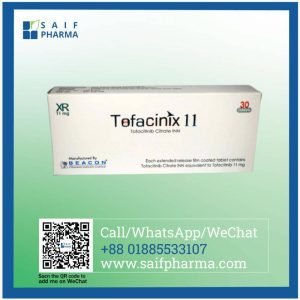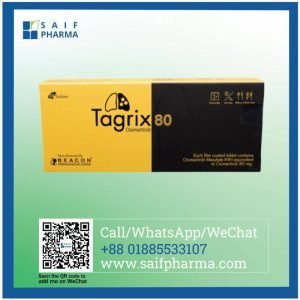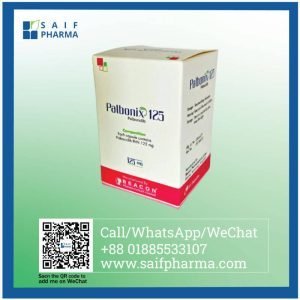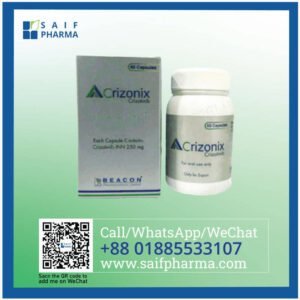Ponaxen 15 mg (Ponatinib)
Generic Name Ponatinib
Other Brand Name Ponaxen
Packing 30
Form Tablet
Strength 15mg, 45mg
Manufacturer Everest Pharmaceuticals Ltd.
COMPOSITION
PONAXEN 15 Tablet: Each film-coated tablet contains Ponatinib Hydrochloride INN equivalent to Ponatinib 15 mg.
PONAXEN 45 Tablet: Each film-coated tablet contains Ponatinib Hydrochloride INN equivalent to Ponatinib 45 mg.
INDICATIONS AND USAGE
Chronic Myeloid Leukemia (CML)
Ponatinib is indicated in adult patients with chronic phase, accelerated phase, or blast phase chronic myeloid leukemia (CML) who are resistant to dasatinib or nilotinib; who are intolerant to dasatinib or nilotinib, and for whom subsequent treatment with imatinib is not clinically appropriate; or who have the T3151 mutation.
Philadelphia chromosome-positive acute lymphoblastic leukaemia (Ph ALL)
Ponatinib has been indicated in adult patients with Philadelphia chromosome-positive acute lymphoblastic leukaemia (Ph ALL) who are resistant to dasatinib; who are intolerant to dasatinib and for whom subsequent treatment with imatinib is not clinically appropriate; or who have the T315! mutation.
DOSAGE AND ADMINISTRATION
Therapy should be initiated by a physician experienced in the diagnosis and treatment of patients with leukemia. Haematol- logic support such as platelet transfusion and hematopoietic growth factors can be used during treatment if clinically indicated.
Before starting treatment with ponatinib, the cardiovascular status of the patient should be assessed, including history and physical examination, and cardiovascular risk factors should be actively managed. Cardiovascular status should continue to be monitored and medical and supportive therapy for conditions that contribute to cardiovascular risk should be optimized during treatment with ponatinib.
RECOMMENDED DOSAGE
The recommended starting dose is 45 mg of ponatinib once daily. Treatment should be continued as long as the patient does not show evidence of disease progression or unacceptable toxicity. Discontinuing ponatinib should be considered if a complete haematologic response has not occurred by 3 months (90 days).
The risk of arterial occlusive events is likely to be dose-related. Reducing the dose of ponatinib to 15 mg should be considered for CP-CML patients who have achieved a major cytogenetic response taking the following factors into account in the individual patient assessment: cardiovascular risk, side effects of ponatinib therapy, time to cytogenetic response, and BCR-ABL transcript levels. If dose reduction is undertaken, close monitoring of response is recommended.
DOSAGE MODIFICATIONS
Dose modifications or interruption of dosing should be considered for the management of hematological and non-hematological toxicities. In the case of severe adverse reactions, treatment should be withheld.
For patients whose adverse reactions are resolved or attenuated in severity, ponatinib may be restarted and escalation of the dose back to the daily dose used prior to the adverse reaction may be considered, if clinically appropriate.
Dose modifications for neutropenia (ANC* < 1.0 x 109/L) and thrombocytopenia (platelet < 50 x 109/L) that are unrelated to leukaemia are summarized in Table 1.
Table 1 Dose modifications for myelosuppression
ANC* < 1.0 x 10*9/L or platelet < 50 x 10*9/L First occurrence: Ponatinib should be withheld and resumed at the same dose after recovery to ANC = 1.5 x 10*9/L and platelet > 75 x 10%/L
Recurrence at 45 mg:
Ponatinib should be withheld and resumed at 30 mg after recovery to ANC > 1.5 x 10%L and platelet > 75 x 10%/L
Recurrence at 30 mg:
Ponatinib should be withheld and resumed at 15 mg after recovery to ANC > 1.5 x 10%/L and platelet > 75 x 109/L







